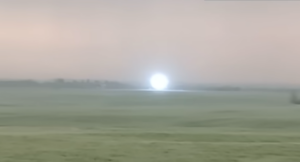Within days of each other, two images of floating vessels have gone viral. Last week, David Morris photographed a seemingly levitated ship off England’s Cornish coast. Then Dave Medlock snapped a hovering cruise liner while walking his dog on, coincidentally, that same coast of Cornwall.
Why Cornwall and what exactly is happening?
Superior mirages: better than the usual kind
Experts quickly dispelled fantastical claims of UFOs and secret military tests. Both images are examples of a superior mirage, where an object apparently lifts into the air. Sometimes it appears out of focus. Other times, it even floats upside-down.
Such mirages are more common in colder regions, which is why arctic explorers often saw them in spring and summer. With the more familiar summer mirages, hot air near the ground and cooler air above create a distorted reflection of the sky that looks like water on the ground. In the movie Lawrence of Arabia, Omar Sharif first emerges out of what looks like a rippling lake.

In our first glimpse of Omar Sharif’s character Ali, he seems to be approaching over water: the inferior mirage we’re all familiar with in hot weather.
Superior mirages are just the opposite. Here, cooler air near the ground (or sea) and warmer air above it creates a refracting lens that elevates distant objects. Superior mirages refract; inferior mirages reflect.
Last week, the weather was pretty good in Cornwall for mirages: mild weather, some sunny spells, little wind to mix the air layers, and cold water.
The most common form of superior mirage is called the Fata Morgana. It was named after the sorceress of Arthurian legend whose specialty was casting illusions of nonexistent islands and castles in the sky to deceive sailors.

A distant island and boats take flight off the coast of Cuba. Photo: Shutterstock
In the early 19th century, Scottish whaler William Scoresby saw an upside-down ship in the Arctic. It was so detailed that he recognized his father’s vessel, which he later determined was about 35km away. His crew witnessed even more complex forms, reporting “innumerable collections of spires and pinnacles, or in the form of a thick forest of naked trees.”

The talented Scoresby sketched his mirage.

Superior mirages sometimes resemble tree-covered islands. There is no actual land in the picture, just distant pieces of ice on the Arctic Ocean. Photo: Jerry Kobalenko

Fata Morgana off Devon Island, in the Canadian Arctic. Unlike the familiar shimmering mirage on hot pavement, which is a reflection of the sky, superior mirages distort distant objects like icebergs, ships, or islands. Photo: Jerry Kobalenko
How mirages form
Fata Morganas take on many forms. When the air on top is much warmer than the air below, an atmospheric duct distorts the image to appear as a combination of upside-down and right-side-up images. Both Cornwall ships appeared to float or “loom” right-side up. Which you see depends on your position and distance from the object.

How Fata Morganas form. Illustration: Wikipedia
John Greivenkamp of the University of Arizona explains that weather conditions produce “layers of air with different temperatures and therefore different indices of refraction.” The sun’s light is bent downwards as it travels through these differing air densities. These lensing effects can be sharp, as in last week’s two ships, out-of-focus, right-side up, or upside-down.
Fata Morganas often vanish or change dramatically within seconds.
While this may not be as exciting as aliens, it is something worth looking for. Superior mirages are not uncommon, especially around cold oceans, but most of them appear very far away and you need a long lens to capture the image.






